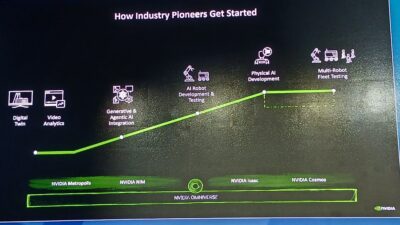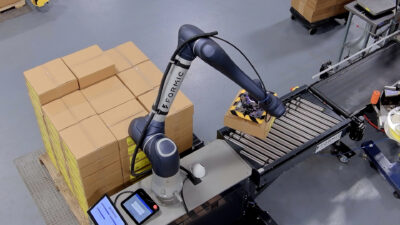There are many standards that need to applied in a variety of automated guided vehicle (AGV) application scenarios.

AGV safety insights
- Ensuring the safety of automated guided vehicles (AGVs) in industrial settings requires compliance with standards such as ISO 3691-4, which outlines necessary safety measures like personnel detection, speed control and braking systems to mitigate risks.
- A context-sensitive safety approach and adherence to comprehensive standards are essential for protecting both humans and industrial assets, as AGVs become integral to automated operations in increasingly complex production environments.
To ensure reliable performance and safety, manufacturers, suppliers, integrators and operators need to assess and validate robot compliance against a range of different standards, as well as considering application-specific requirements. Automatic guided vehicles (AGV) and automated vehicle systems are becoming increasingly indispensable for automated operations as they provide continuous service around the clock and can be flexibly assigned for a variety of applications, their contribution to increased efficiency and productivity is significant.
An AGV is a floor-based conveyor network with the primary task of transporting materials, both within industrial buildings and across company premises, helping to automate and optimize logistics processes. AGVs consist of the following elements – one or more automated guided vehicles, a master control system, equipment for location determination and position detection, equipment for data transmission, infrastructure and peripheral equipment. However, this equipment poses hazards to humans, with risks growing alongside increasing human interaction with AGVs.
ISO 3691-4:2023 – Industrial trucks — safety requirements and verification — Part 4: Driverless industrial trucks and their systems marks a crucial advance in autonomous vehicle safety guidelines
Know your ABCs
Regarding machinery safety, ISO and EN standards are categorized in three types:
-
Type-A: Basic safety standards containing principles of design and general aspects that can be applied to all machinery.
-
Type-B: Group safety standards that cover a safety aspect or protective device relevant to a wide range of machinery.
-
Type-C: Contain the safety requirements for a specific machine or type of machine
A Type-C standard has priority over Type-A and Type-B.
ISO 3691-4 is a Type-C standard because it contains the safety requirements for a specific type of machine, and it applies to all stakeholders – machinery manufacturers, integrators and operators. This ensures there is co-responsibility to create a unified approach towards AGV safety and risk management. It outlines the safety requirements for driverless industrial vehicles and their systems, as well as how to check that they meet those requirements. First published in February 2020, and further updated last year, this standard is still relatively new to the machinery world.
The standard defines the performance levels that are required of safety functions, as well as describing the necessary procedures to reduce risk and to enable validation of the automated functions. Three key aspects must therefore be taken into account:
-
Operating environment (different zones where the truck operates and interacts with humans).
-
Associated hazards and risks.
-
Correct implementation of safety systems (protection).
To give an example, an AGV navigating towards a machine in an operating area with a human presence represents a “collision risk”. According to ISO 3691-4, this risk may be mitigated by using three safety measures incorporated in AGV design:
-
Personnel detection system
-
Speed control system
-
Braking system control
In current practice, speed limitations due to a human presence are therefore applied even if there are no humans in the actual AGV operating area.
Likewise, in a confined area, with no human presence allowed, an AGV making its final approach to a machine for docking may pose a collision risk between two industrial assets. This unsafe docking event risk may be mitigated by using two safety measures incorporated in AGV design:
-
Speed control system
-
Parking braking system control
Ensuring protection
Although there is no risk for humans in a confined area, the measures are necessary to protect industrial assets from expensive damage. The use of a context-sensitive safety approach could achieve the goal of property protection combined with higher system efficiency.
The condition of the operating environment has a significant effect on the safe operation of a truck. So, Annex A, which covers the requirements for the preparation of the operating zones, must be used to eliminate hazards when preparing the operating zone.
Annex B lists all significant hazards, hazardous situations or hazardous events that must be considered during the life of the truck. Not only should this include hazards relevant to the machine when it is being used as intended, this should also cover conditions of misuse that are considered reasonably foreseeable by the manufacturer. The Performance Level (PL), found in ISO 13849, for the different safety functions are based on the hazards listed in this annex.
When designing the safety functions, it is vital that the complete system is taken into account so that the interrelationships between the multiple functions of the AGV are considered to optimize safety, for the protection of operators and other assets around them. For example, the AGV’s control system must manage both safety and non-safety functions, so it must be taken into account that some safety functions may not only impact safety, but also non-safety functions.
Machinery safety standards define a set of general physical hazards that are used during type certification. However, current standards, such as ISO 3691-4 have not been designed around the concept of machine connectivity and interoperability. While Industry 4.0 sees reduced risk in several areas, the range and flexibility of connected interfaces introduce a new set of risk issues. As production facilities become more complex, operators must manage a rapidly evolving system that incorporates multiple interdependencies, while minimizing downtime.
When faced with the challenge of navigating a complex new risk landscape, effective safety is a key challenge. However, it is becoming increasingly impossible to apply existing risk assessment criteria to a dynamic I4.0 operating environment that is characterized by multiple interactions and data flows. Machinery manufacturers and end users therefore face a major shift in work methodology, which requires a new approach.
For now, ISO 3691-4 takes us a step further as it is well aligned with ISO 13849. This is a safety standard which applies to parts of machinery control systems that are assigned to providing safety functions. It provides safety requirements and guidance on the principles of design, and the integration of safety-related parts of control systems (hardware or software). So, it provides invaluable guidance for carrying out safety assessments for the complete AGV. It is therefore clear that ISO 3691 should not be seen a standalone document to assume conformity with other AGV standards and the EU’s Machinery Directive, its new machinery regulation or the UK’s Supply of Machinery (Safety) Regulations.
– This originally appeared on Control Engineering Europe.



